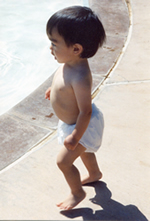Frequently Asked Questions
- How is the Kentro method different from stretching/fitness/body awareness/postural
methods?

Smooth balance refers to comfortable weight distribution, not to body shape.
- The Kentro program reverses notions and goals that are typical of conventional stretching programs. For example, we are told to touch the toes by stretching our hands toward the toes and usually wind up rounding the upper back. This results in the same joint/muscular strain as in the ‘slouching’ standing position. Mostly we over-stretch tissues that are already strained and thus further distress them. Instead, the Kentro method of centering movements combines an affectionate attitude towards our bodies with sound anatomical function. Ms. Thusius has completed 35 years of field word and studies of men and women (in twelve countries) who stay resilient into old age. They stay agile because they are strengthened with and limbered by their activities. Kentro can dissolve joint and muscular ‘holding patterns’ when we let our activities stretch us, in accord with our body history.
-
With Kentro practice we can reverse stressful beliefs about our bodies and prevent pushing our bodies into shape. Instead, Kentro reflects the true meaning of the word ‘fitness’. Incorporating Kentro centering movements with activities like lifting, carrying groceries, preparing food, sweeping and gardening is enough to keep us fit and limber. Weight lifting (with actual weights) is excellent when practiced with centered motion.

Bending with a centered pelvis
straightens the back. - Body awareness is useful as a first step to noticing how we move. However, awareness is not enough because it does not offer specific instructions for safe and healthy motion based on our physiology and sensory system. Practicing Kentro right away enlivens our kinesthetic sense of fluid motion. We feel the difference between straining/centering precise areas of our body.
- Kentro uniquely reverses all concepts of ‘correct’ or ‘ideal’ posture. With Kentro centering movements, there is no need to let go of stressful holding patterns because solid structural guidelines combined with a friendly attitude empowers our bodies to generate fluid motion and well-being.
- Are
the Kentro movements appropriate for everyone?
Yes. The movements are very gentle and with practice, easily sensed. Centered motion is available to anyone who is reasonably healthy, regardless of ‘body shape’ or ‘body size’. We benefit from Kentro at any age, during any activity, from walking to weight-lifting. - Do the suggestions we were told as children
(by our parents) to ‘stand up straight’ correspond with Kentro?
No. There are no prescribed forms or postures with Kentro practice. We sense how to center ourselves from the inside out. Kentro centering practice is excellent preparation for a vitalizing, safe and profound experience of everyday and specialized activities, such as Chi-gong, dance, meditation, sports and exercise. - Are there any Kentro postures?
No. Kentro is based on optimal anatomical function combined with an open mind and an affectionate attitude toward our bodies. Merging function with feeling and a fresh view of our bodies enables us to move with centered motion - personal postural expression. - Where and when do we practice Kentro movements?
We can integrate Kentro movements anytime with ordinary or specialized activities such as Yoga, fitness or Tai chi. Any place is appropriate for practicing Kentro. - Do we need any props or equipment to practice?
No. Our muscles already know how to stretch harmoniously. Using conventional props/equipment restricts our sensing of fluid fitness and ease. As we practice Kentro, our bodies re-stretch into healthy, unhampered function. We will feel more and more how to move with natural ease without the risk of straining, over-contracting or over-stretching muscles. - Does Kentro have anything
in common with Yoga, Tai-chi, Chi-gong and Aikido?
Yes. Kentro and all these traditional practices emphasize a flowing connection between body, mind and spirit. Kentro expands on the importance of the physical and subtle aspects of the main center (pelvic area) of the body. The pelvis is the principal fulcrum (hub) of our bodies for free motion. This essential area is referred to in Sanskrit as 'asana'; in Chinese 'dantien'; and in Japanese, 'hara'. It is like the 'hub' of a wheel: when the hub isn't centered, the spokes weaken. - How is Kentro different from Feldenkrais, Alexander-Techinque, Pilates, Yoga, Tai-Chi, Chi-gong and Martial Arts? Kentro:

As very young children, we all moved with resiliency - strong and relaxed.
- Provides centering movements based on over thirty-five years of researching healthy motion.
- Centering movements serve as a foundation and preparation for smooth, enjoyable everyday/specialized activities and body movement methods.
- Merges precise anatomical guidelines with an affectionate attitude toward our bodies for profound benefits.
- Highlights starting all activities by moving from the pelvis (the main center of the body).
- Is innovative in its approach to fitness (our movements fit well with our activities).
- Frees us from all concepts of ‘ideal’, 'correct' posture and forms (there are no goals, nothing to be achieved, no discipline, no struggle, no taming of our posture.)
- Why is an affectionate
attitude toward our bodies such an important ingredient for Kentro
practice?
We may push our bodies into bone alignment and weight-distribution and still dislike our outer appearance. With Kentro, kindness toward our bodies promotes the release of holding patterns. Our chores then become pleasurable. We enjoy how we feel and how our muscles reshape our bodies. - What is the basis for the Kentro method?
For over thirty-five years, throughout twelve different countries, Angelika Thusius-creator of Kentro has:
- Researched the motion of men and women who remain resilient into old age.
- Observed the motion of young children
- Completed original comparative anatomical studies at medical libraries in the U.S., England, France and Greece
- Collected positive feedback (over twenty-five years) from Kentro students
- Noted her personal experience of overcoming all postural pain and stiffness
- Enquired into societal misconceptions of aging and postural expression
- Are
Kentro movements similar to conventional exercise regimens?
No. Conventional exercise programs mostly tell us to ‘tuck’ the pelvis, ‘arch’ the lower back, ‘hold’ in the belly, ‘push’ back the shoulders ‘raise’ up the ribcage and chin. Lifting and carrying actions then originate from tight and weak back, shoulder, pelvic and leg muscles. Frequently, the goal is to stretch and ‘work out’ by pushing our bodies into shape, thus further straining the tissues. With Kentro there is no goal – we simply practice centered motion at our own rhythm, sensing what is appropriate for our bodies. The shoulders relax, the lower and upper back straighten. Pelvic, leg and back muscles then become strong without effort. - Do we
have to go to the gym or lift weights at home to be strong?
No. It is helpful to know that many adults who remain limber and strong into old age - whether they are doing demanding physical work or sitting at desks all day - are naturally stretched and strengthened in their ordinary activities. Some professionals, like athletes and dancers, go to gyms because they need extra strength and suppleness. Others simply like to go to the gym.
This Greek sailor is centered, pulling the rope from strong buttocks, back and thigh muscles.
 See
the mage of a man lifting weight. The figure on left is centered; the
figure on the right is strained. Yet, if we use gym equipment without
centered motion, we risk aggravating stressed tissues even further. Adapting
conventional stretching/strengthening with Kentro movements will make
all motions safer and will deepen physical benefits. However, if going
to the gym isn’t our ‘cup of tea’, we can simply practice Kentro movements
for feeling strong in our daily lives. Fitness means
our movements adapt well with our activities and the environment.
See
the mage of a man lifting weight. The figure on left is centered; the
figure on the right is strained. Yet, if we use gym equipment without
centered motion, we risk aggravating stressed tissues even further. Adapting
conventional stretching/strengthening with Kentro movements will make
all motions safer and will deepen physical benefits. However, if going
to the gym isn’t our ‘cup of tea’, we can simply practice Kentro movements
for feeling strong in our daily lives. Fitness means
our movements adapt well with our activities and the environment. - Do Kentro guidelines
promote regular stretching and strengthening?
Yes. Most of the 80 Kentro centering movements both stretch and strengthen our bodies. Kentro reverses the conventional approach of ‘coping’ with pelvic and back problems and relying on palliative help. Some movements stretch and tone precise areas and may be practiced on their own. Radically, by centering our movements with our activities, the stretching/strengthening simply happens. - Is it necessary to tighten the abdominals and ‘suck-in’
the belly to lift something with a straight back?
No. Physiologically when we bend forward and tighten the belly, the pelvis is tucked and the sacrum is straightened. As a result, the buttocks (the strongest weight-bearing muscles) and pelvic muscles including the abdominals are weakened. The entire back weakens: the lower back arches, the upper back curves. We have to compensate by lifting from the tight shoulders. With centered placement we bend from a centered pelvis – the main fulcrum of our bodies. Pelvic, back and leg muscles then become strong and the back straightens. We then lift with ease because our naturally strong back, pelvic and leg muscles can work well. - What is the relationship
between Kentro, energy medicine, massage, CranioSacral, chiropractic
and acupuncture treatments?
Kentro enhances and deepens the benefits from these therapies. Centered motion improves circulation, bone-strength, breathing and oxygenation. It may resolve postural musculo-skeletal symptoms. Kentro also helps us embody our subtle levels of being. - Where
can we find Kentro classes and teachers?
Ms. Thusius offers one-on-one and group classes as well as workshops in Ashland, Oregon. She is available for teaching workshops elsewhere. A Kentro Teacher Training Program is in preparation. For more information on Kentro classes and projects, please contact Angie.

This Balinese woman bends with weight assimilated through strong buttocks/hips area.